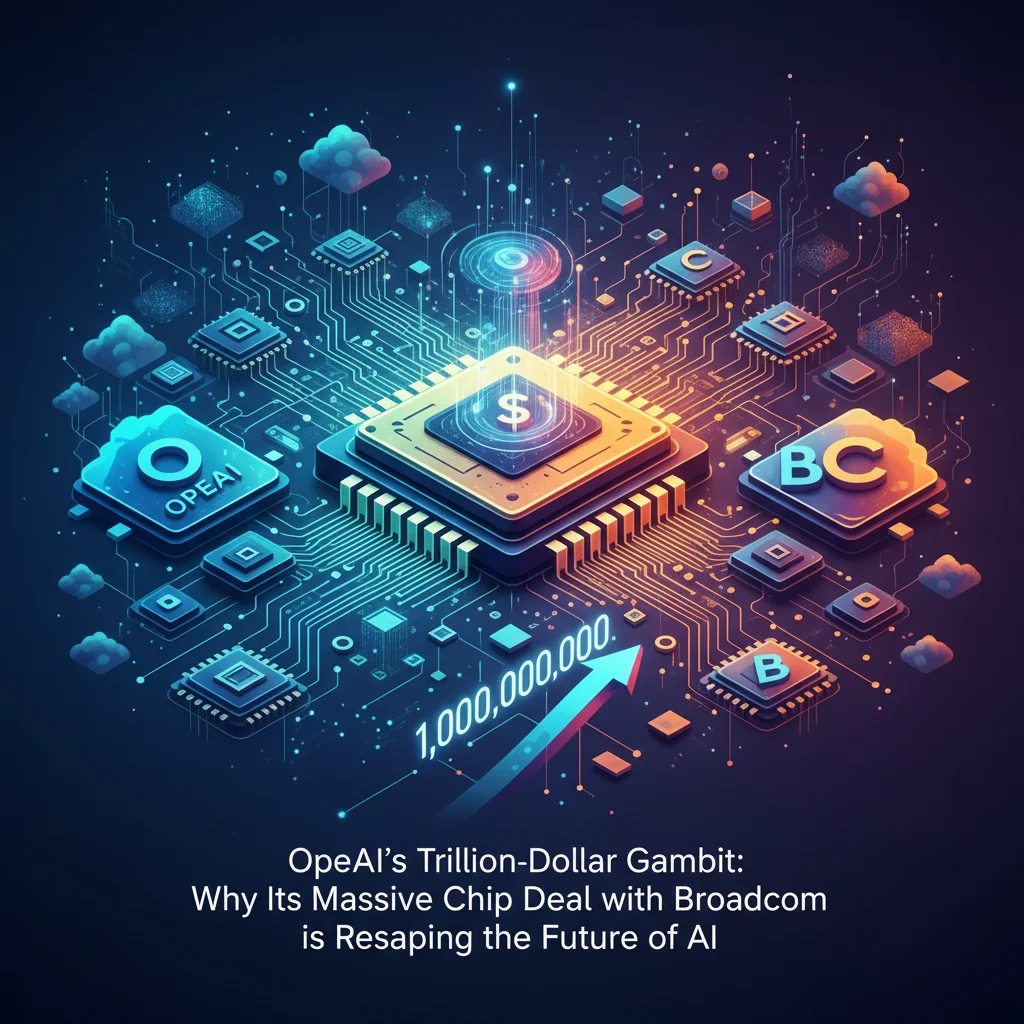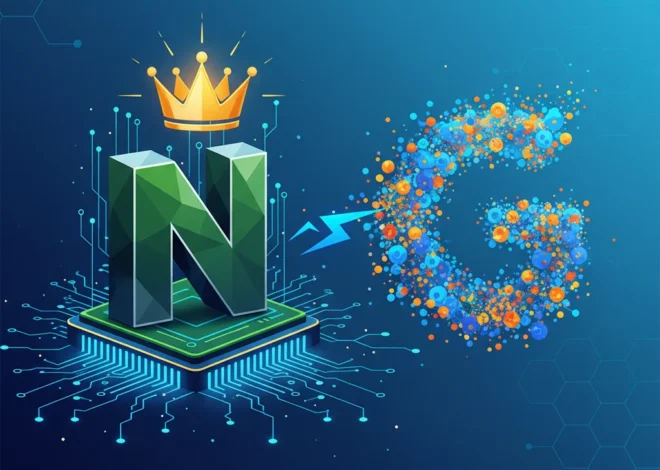
OpenAI’s Trillion-Dollar Gambit: Why Its Massive Chip Deal with Broadcom is Reshaping the Future of AI
In the world of artificial intelligence, we’re used to hearing big numbers. Billions of parameters in a model, trillions of data points in a training set. But every now and then, a number comes along that is so colossal, so audacious, it forces everyone to stop and recalibrate their understanding of the future. OpenAI, the company behind ChatGPT, has just put one of those numbers on the table.
The headline news is a multi-billion dollar deal with semiconductor giant Broadcom to develop custom-built AI chips. But the truly mind-bending figure, as reported by the Financial Times, is that this is part of a potential $1 trillion pledge for semiconductors and data centers. Let that sink in. One trillion dollars. That’s not just buying hardware; it’s a nation-state-level investment in building the very foundation of tomorrow’s intelligence.
This isn’t just another line item on a balance sheet. It’s a seismic shift in the AI landscape. It’s a declaration that the future of AI won’t just be written in code; it will be etched in silicon. For developers, entrepreneurs, and anyone invested in the tech industry, this move signals a new chapter in the AI arms race—one where controlling the hardware is just as important as designing the software.
The GPU in the Room: Why OpenAI is Looking Beyond Nvidia
To understand the gravity of this deal, you first need to understand the current state of AI hardware. For the past few years, the AI gold rush has been powered by one company’s “picks and shovels”: Nvidia. Their GPUs (Graphics Processing Units), like the highly coveted H100, have become the de facto standard for training and running large-scale machine learning models. They are powerful, versatile, and have given Nvidia an almost monopolistic grip on the market.
However, this dominance creates a massive bottleneck for companies like OpenAI. Relying on a single supplier for the most critical component of your infrastructure is a risky proposition. It leads to several key challenges:
- Supply Constraints: The demand for high-end GPUs far outstrips supply, leading to long wait times and intense competition for resources.
- Sky-High Costs: With little competition, prices for these essential chips remain astronomically high, making it incredibly expensive to scale AI operations.
- One-Size-Fits-All: GPUs are general-purpose processors. While they are excellent for a wide range of tasks, they aren’t perfectly optimized for the specific workloads of a model like GPT-4 or its successors. This means there’s a ceiling on efficiency.
For a company with ambitions as grand as OpenAI’s—namely, the creation of Artificial General Intelligence (AGI)—being dependent on another company’s roadmap is untenable. They need a custom solution tailored to their unique needs, and that’s where Broadcom enters the picture.
The Custom Silicon Solution: What is an ASIC and Why Does It Matter?
OpenAI isn’t just buying off-the-shelf chips from Broadcom. They are co-developing Application-Specific Integrated Circuits, or ASICs. Think of it like this: a GPU is a high-end, multi-tool pocketknife. It can do many things very well. An ASIC, on the other hand, is a surgeon’s scalpel—designed with extreme precision for one specific job.
In the context of artificial intelligence, an ASIC is designed from the ground up to perform the exact mathematical operations required for running a specific type of AI model. This specialization brings incredible benefits:
- Peak Performance: By stripping away unnecessary components, the chip can execute its core tasks much faster.
- Greater Energy Efficiency: Custom design means less wasted energy, which is a critical factor when you’re running data centers the size of small cities. This translates to significantly lower operational costs.
- Competitive Moat: A custom chip is a proprietary piece of technology. It gives OpenAI an architectural advantage that competitors can’t easily replicate, separating their software and models from the underlying hardware.
Broadcom is the perfect partner for this endeavor. They are a quiet giant in the semiconductor world, with a long history of building custom ASICs for the biggest names in tech. They were instrumental in developing Google’s Tensor Processing Units (TPUs) and have worked with Meta on their custom AI hardware. This deal brings together OpenAI’s leading-edge AI research with Broadcom’s world-class chip design expertise.
A Staggering Investment in the Future
To put OpenAI’s financial commitment into perspective, let’s break down the numbers mentioned in the reports. This isn’t just a simple purchase; it’s a long-term strategic allocation of capital designed to secure a decade of innovation.
| Investment Area | Potential Cost | Strategic Goal |
|---|---|---|
| Broadcom Custom Chip (ASIC) Deal | Up to $500 billion (source) | Reduce Nvidia dependency, increase performance and efficiency, and create a proprietary hardware advantage. |
| Overall Semiconductor & Data Center Pledge | Up to $1 trillion (source) | Build the global infrastructure required for developing and deploying Artificial General Intelligence (AGI). |
But let’s consider the flip side. A $1 trillion investment creates an almost impossibly high barrier to entry. What does this mean for other startups in the AI space? It suggests the future of foundational models may be a game only playable by a handful of trillion-dollar companies and super-funded labs. The era of building a new large language model “in the garage” is definitively over. The real opportunity for innovation for most will be in the application layer—building on top of these massive, utility-like AI platforms. This move effectively solidifies the power of the incumbents and forces the rest of the ecosystem to adapt.
The Trillion-Dollar Question: Paving the Road to AGI
Why spend such an astronomical sum? Because Sam Altman and OpenAI believe that the current hardware paradigm is simply not enough to get them to their ultimate goal: Artificial General Intelligence. AGI, a hypothetical form of AI that can understand, learn, and apply knowledge across a wide range of tasks at or above human-level intelligence, will require computational power that dwarfs today’s systems.
This investment is a bet that the path to AGI requires a fundamental rethinking of the entire technology stack, from the transistors on a chip to the architecture of the data center. It’s an attempt to build the engine for a car that hasn’t been fully designed yet. This proactive approach to infrastructure is what separates the leaders from the followers in the tech world.
The implications will ripple across the entire tech ecosystem. The cloud computing landscape, dominated by AWS, Google Cloud, and Azure, will have to contend with a major player that owns its entire stack. The SaaS industry, increasingly built on AI-powered features, will become even more reliant on the foundational models that run on this custom hardware. And for industries like automation and cybersecurity, the next generation of models powered by this infrastructure will unlock capabilities we can only begin to imagine.
What This Means for You: The Ripple Effect on the Tech World
A deal of this magnitude isn’t just an abstract corporate maneuver. It has tangible consequences for everyone working in or with technology.
For Developers and Tech Professionals: The era of hardware-agnostic programming is being challenged. As custom silicon like this becomes more prevalent, the ability to optimize code for specific architectures will become a highly sought-after skill. Understanding the interplay between software and hardware will no longer be a niche specialty but a core competency for building high-performance AI systems.
For Entrepreneurs and Startups: The message is clear: do not try to compete on building foundational models unless you have a nation’s GDP to spend. The strategic ground has shifted. The most fertile territory for startups is now in creating novel applications, fine-tuning models for specific industries, and building the tools and services that support the larger AI ecosystem. Find a niche that these giants are too big to focus on.
For the General Public: This is the long, expensive, and complex work required to build the future of AI that will eventually power everything from medical diagnostics and scientific discovery to personalized education and entertainment. While the immediate impact won’t be obvious, this investment is laying the groundwork for the next decade of technological progress.
Conclusion: The Silicon Foundation of Intelligence
OpenAI’s partnership with Broadcom and its staggering trillion-dollar ambition is a watershed moment for the artificial intelligence industry. It signals a maturation from a software-centric field to one where hardware and software are deeply and inextricably linked. It is a bold, expensive, and risky bet on a future where intelligence is not just coded but is forged in custom-designed silicon.
This isn’t just about buying more chips; it’s about building a better, more efficient, and more powerful engine for intelligence itself. As this new hardware comes online in the coming years, it will fuel the next wave of AI innovation, setting the stage for a future that is rapidly moving from science fiction to reality.


